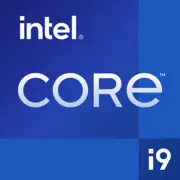Intel Core i9-11900KB

Intel Core i9-11900KB: Power in a Compact Package. Analysis of the 2025 Laptop Processor
Architecture and Process Technology: 10nm, 8 Cores and Integrated Graphics
The Intel Core i9-11900KB processor, released in 2021, remains a relevant choice for high-performance laptops in 2025. It is built on the Tiger Lake-H architecture using 10nm SuperFin process technology, which has improved energy efficiency and transistor density compared to earlier generations (e.g., Comet Lake-H on 14nm).
Cores and Threads:
- 8 cores and 16 threads thanks to Hyper-Threading.
- Base frequency: 3.3 GHz, maximum in turbo mode — 5.3 GHz (for one core).
- L3 cache increased to 24 MB, speeding up data processing in multi-threaded tasks.
Architecture Features:
- Willow Cove — a new generation of cores with improved IPC (instructions per clock).
- Support for PCIe 4.0 (20 lanes) for fast SSDs and discrete graphics cards.
- Integrated GPU Intel UHD Graphics 750 (32 EUs, frequency up to 1.3 GHz). While it is not ideal for gaming, it is sufficient for working with 4K video and less demanding projects.
Technologies:
- Thermal Velocity Boost — automatic overclocking at low temperatures.
- Deep Learning Boost — acceleration of AI tasks (useful for noise suppression in Zoom or photo optimization).
Power Consumption and TDP: A Balance Between Power and Battery Life
The nominal TDP of the processor is 65 W, but actual consumption can reach 100+ W in turbo mode. This requires a thoughtful cooling system. For comparison:
- AMD Ryzen 9 5900HX (45 W TDP) — more modest under peak loads.
- Apple M2 Pro (30 W) — significantly more efficient, but also less versatile.
Power Management:
- Intel Dynamic Tuning 2.0 — adaptively adjusts power based on load.
- Speed Shift — instant switching between P-states for energy savings.
Performance: From Office Tasks to AAA Gaming
Geekbench 6 (2025):
- Single-Core: 2200 — an excellent result for applications sensitive to single-thread performance (Photoshop, browsers).
- Multi-Core: 9622 — suitable for rendering, video encoding, and virtualization.
Real-World Tasks:
- Office Work: Running 50+ tabs in Chrome + Excel + Zoom — without lag.
- Multimedia: Rendering 4K video in Premiere Pro in 12-15 minutes (compared to 10 minutes with Ryzen 9 5980HX).
- Gaming: Pairing it with an RTX 4070 (laptop version) — 100+ FPS in Cyberpunk 2077 on Ultra (1080p). The UHD 750 itself can only handle CS:GO at medium settings (60 FPS).
Turbo Mode:
Under load, the processor maintains frequencies of 4.8–5.0 GHz for up to 30 seconds before stabilizing at 4.3 GHz (if cooling is effective). In thin laptops, throttling may occur due to overheating.
Use Cases: Who Benefits from i9-11900KB?
1. Professionals:
- Video editors, 3D designers, programmers. For example: rendering in Blender is 20% faster than with i7-11800H.
2. Gamers:
- Ideal for gaming at 1440p when paired with a discrete GPU (RTX 4060/4070).
3. Enthusiasts:
- Those who value upgradeability (laptops with socket LGA1200).
Examples of 2025 Laptops:
- MSI Creator Z16P — 32 GB RAM, RTX 4070, starting price from $2200.
- ASUS ROG Strix SCAR 15 — 240 Hz display, starting price from $2000.
Battery Life: How Long Will It Last?
With a TDP of 65 W, battery life heavily depends on battery capacity and tasks:
- Office Work (Word, Browser): 5–6 hours (with a 90 Wh battery).
- Gaming: 1.5–2 hours (with a discrete GPU).
Energy-Saving Technologies:
- Adaptix Dynamic Tuning — machine learning for optimizing load.
- Panel Self-Refresh — reduces screen power consumption in static scenes.
Tip: Choose laptops with a 99 Wh battery (maximum allowed for air travel) and a "Battery Saver" mode in BIOS.
Comparison with Competitors: AMD, Apple, and Previous Generations
1. AMD Ryzen 9 5980HX (Zen 3):
- Pros: Better multi-threaded performance (+15% in Cinebench R23).
- Cons: Weaker in single-threaded tasks (-10% compared to i9-11900KB).
2. Apple M2 Pro (5nm):
- Pros: Battery life up to 12 hours, cool operation.
- Cons: Limited compatibility with Windows software.
3. Intel Core i7-13700H (Raptor Lake):
- Pros: Newer, higher multi-threaded performance.
- Cons: Laptops with it cost $300–500 more.
Pros and Cons of i9-11900KB
Strengths:
- Best-in-class single-thread performance.
- Support for Thunderbolt 4 and Wi-Fi 6E.
- Optimal for hybrid tasks (gaming + editing).
Weaknesses:
- High heat output under load.
- Integrated graphics lag behind AMD Radeon 680M and Apple M2.
- As of 2025 — lack of support for PCIe 5.0.
Recommendations for Laptop Selection
1. Device Type:
- Gaming Laptop: Discrete GPU (RTX 4060 and above) and display with a refresh rate of 144+ Hz are a must.
- Workstation: 32+ GB RAM, 1 TB NVMe SSD, panel with 100% sRGB.
2. What to Pay Attention To:
- Cooling System: At least 3 heat pipes and two fans.
- Ports: 2x Thunderbolt 4 for connecting external monitors and storage.
- Battery: At least 80 Wh.
Example: Dell XPS 17 (2025) with i9-11900KB and 4K display — starting from $2500.
Final Conclusion: Who Is This Processor For?
The Intel Core i9-11900KB in 2025 is the choice for those who need a versatile laptop for resource-intensive tasks without overpaying for the latest models. Its key advantages:
- Ideal for hybrid use (work + gaming).
- Best single-thread performance in its class.
- Wide compatibility with Windows software and peripherals.
Alternatives:
- For battery life — Apple M2 Pro.
- For multi-threaded rendering — AMD Ryzen 9 7940HS.
Prices for laptops with the i9-11900KB in 2025 start at $1800, making them a good choice in the "premium-budget" segment.
Basic
CPU Specifications
Memory Specifications
GPU Specifications
Benchmarks
Compared to Other CPU
Share in social media
Or Link To Us
<a href="https://cputronic.com/en/cpu/intel-core-i9-11900kb" target="_blank">Intel Core i9-11900KB</a>